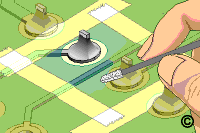No. 2.3.2
Coating Removal, Solvent Method
OUTLINE
This procedure uses a solvent to remove surface coatings. This procedure can be
use for spot or overall coating removal of conformal coatings or solder resists.
Approved solvents may be used to remove specific soluble type coatings on a
spot basis by brushing or swabbing the local area with the controlled
application of solvent until the area is free of the coating material.
If warranted, all the soluble type coating can be removed by immersing and
brushing the entire printed board or printed board assembly.
To determine the appropriate coating removal procedure the coating must first
be identified. Refer to procedure number 2.3.1.
NOTE
Coating removal may require the use of one or more methods.
CAUTION
Determine, on a module by module basis, the hazards to parts, etc., by short
term immersion in the removal solvents. If chloride based or other harsh
solvents are used, extreme care must be exercised to prevent damage to base
material, component parts, plated-through holes, and solder joints. Some solvent
coating removal methods can cause expansion or swelling of the base material
which can degrade the printed board or printed board assembly. Under no
circumstances should these solvents be used except in a closely controlled
process. It is recommended that the printed board or printed board assembly be
inspected to ensure that no damage has occurred.
Before using any solvent refer to Material Safety Data Sheets
TOOLS & MATERIALS
Brushes
Coating Remover Solvent
Foam Swabs
Knife
Tape, Kapton
Thermal Parting Tool
Wood Sticks
PROCEDURE - LOCAL SPOT REMOVAL
- Apply Kapton tape to outline the area where the coating needs to
be removed. (See Figure 1).
- Dip the end of a foam swab in stripping solution and apply a small amount to
the coating to be removed. (See Figure 2)
NOTE
Since various substances may be used as coatings, the time required for a given
coating to dissolve or soften will vary. Reapply solvent several times as most
solvents evaporate rapidly.
- Rub the treated surface carefully with a brush or wood stick to dislodge the
coating. A wedge shaped applicator tip, knife, or heated blade may be effective
in removing some coatings, particularly polyurethanes.
- Neutralize or clean the stripped area and dry.
PROCEDURE - OVERALL REMOVAL
- A single step for removal of all the coating may be completed by providing a
continuous flow of solvent
Alternately, process the board in a series of tanks containing mild solvent,
starting with a high contamination tank and progressing sequentially to a final,
fresh solvent tank.
EVALUATION
- Visual examination or UV light may be used to verify complete removal of
coating.
|
|
|
Solutions Across the Board
TM
|
|
|
|
Product Class: R/F/W/C
Skill Level: Advanced
Conformance Level: High
Revision: E
Revision Date: Jul 7, 2000
Repair Service Charge

Coating Removal Required At Outlined Area

Figure 1: Apply Kapton tape to outline area for coating removal

Figure 2: Apply solvent with a foam swab to remove coating.

Figure 3: Removal complete.
|
Tricks of the Trade
We rarely use this procedure. Most of the solvents used to remove coatings from
circuit board surfaces will attach to circuit board base material. However, when
circumstances allow, this method can be efficient and effective. We will
normally first attempt to use 2.3.5 Coating Removal,
Grinding/Scraping Method or 2.3.6 Coating Removal,
Micro Blasting Method.
|
|
|





